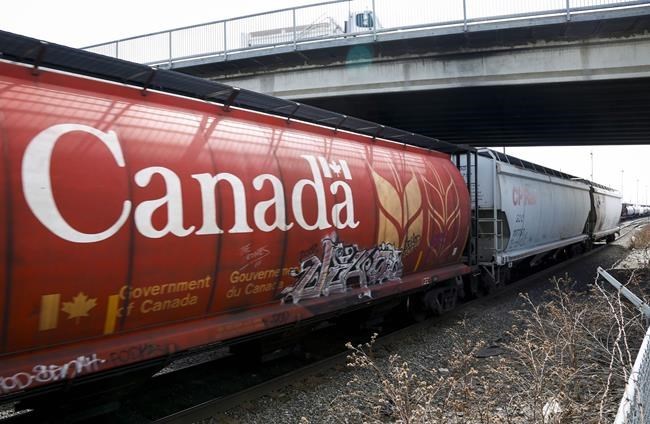TORONTO — Canada's two largest railways say they are unlikely to repeat the record grain shipments they posted in 2020 due to unfavourable weather conditions over the summer.
Canadian National Railway Co. moved 31 million tonnes as of the end of July, beating the previous record of 29.4 million tonnes a year earlier.
That's above its forecast for the year and 2.9 million tonnes more than the three-year average.
"The exceptional last crop production in Western Canada, combined with very high demand for grain in world markets, drove this unique performance," CEO JJ Ruest said in a report presented to the federal government.
Calgary-based Canadian Pacific Railway Ltd. says it moved 31.2 million tonnes, up from 29.52 million tonnes during the 2019-2020 crop year.
The railways say record high temperatures and drought in Western Canada have stressed crops and could have a negative impact on this year's yields if conditions persist.
"CP anticipates the 2021-2022 Western Canadian grain crop volume to be lower than the past two crop years," said the railway's report, adding that its forecast is consistent with the expectation of our customers.
The railway said in a news release that market conditions and a tight grain supply had already led to reduced demand starting in April. Shipper demand through May, June and July was down almost 15 per cent below the same period a year earlier, and 25 per cent below the fall peak, said CP.
Montreal-based CN said in its report that Agriculture and Agri-Food Canada projects that production of six major grains, peas and lentils to be down about five per cent to 73.8 million tonnes while total available supplies should be down 8.6 per cent to 80.7 million tonnes.
Exports are also expected to be below the three-year average levels at 45.2 million tonnes and significantly below the 52.2 million tonnes in 2020-2021.
"We recognize that growing conditions across much of the Prairies have been very challenging as many producers face extremely hot and dry weather this year," added Ruest in a news release.
The reduced shipments are expected despite growing global demand, led by China, for Canadian exports. China is on pace to import record amounts of grain and oilseed this year, driven by the replenishment of domestic stockpiles and the re-establishment of hog herds that were culled between 2017 and 2019 because of the African swine flu.
The railways say they were helped in transporting last year's the bountiful harvest by investing in the purchase of larger hopper cars.
"Our 8,500-foot High Efficiency Product (HEP) train model, together with our new high-capacity hopper cars, produces a train that carries in excess of 40 per cent more grain than our historical 7,000-foot grain train," CP chief executive Keith Creel wrote in the railway's report to government.
He said CP is investing $500 million to renew its fleet of hopper cars. It has more than 4,600 CP-owned and leased new high-capacity
Both railways say the acquisition of U.S. railway Kansas City Â鶹ÊÓƵern would expand their capacity to move more grain products and provide new options for Canadian farmers and customers.
"It will create a new single-line service to a wider array of destinations in the U.S. and Mexico, and will also create an end-to-end transportation network across North America, enhancing competition, spurring economic growth and delivering benefits to the local communities in which both railroads operate," said CN, which is awaiting shareholder and regulatory approvals for its US$33.6-billion offer.
If that bid fails, CP said it is prepared to re-engage with KCS.
"The proposed combined network is a transformative opportunity for Canadian shippers, including grain shippers and farmers, because it would seamlessly connect production-rich CP origins to new export destinations in the U.S. and Mexico."
Walter Spracklin of RBC Dominion Securities says the federal government forecast for principal field crop production anticipates a 3.7 per cent decrease for the next crop year.
He noted that Canadian grain accounts for about two-thirds of total grain volumes at both railways while grain and fertilizers accounted for 20 per cent of CN's 2020 revenues and 24 per cent of CP's revenues.
"We therefore view Canadian Crop production as a key driver of volumes (and earnings) at the Canadian rails."
This report by The Canadian Press was first published Aug. 3, 2021.
Companies in this story: (TSX:CNR, TSX:CP)
Ross Marowits, The Canadian Press
Note to readers: This is corrected story. An earlier version misattributed the source of grain production and export projections for the next fiscal year.




